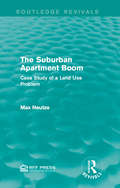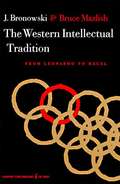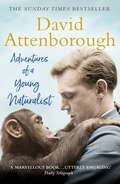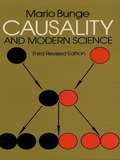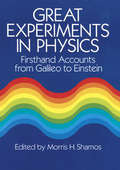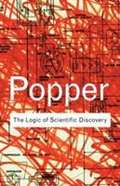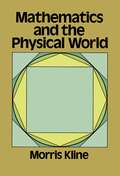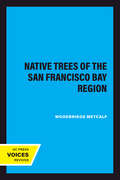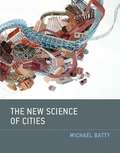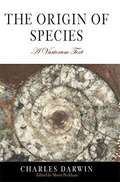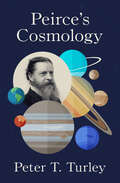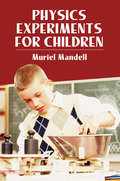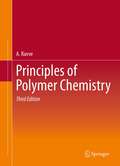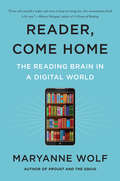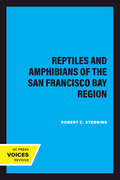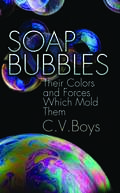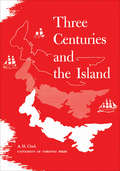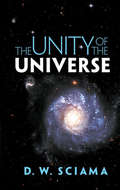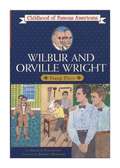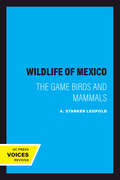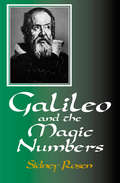- Table View
- List View
The Suburban Apartment Boom: Case Study of a Land Use Problem (Routledge Revivals)
by Max NeutzeWith an increase in urban crises arising from a growing population and rising affluence, and the inadequacy of conventional theories to predict the future states of the environment, Resources for the Future laid out a series of studies on the resource base of the urban environment. Originally published in 1968, this particular study examines the increase of apartment construction in the suburb including the extent of construction and the factors behind construction such as population demographics, highway construction and national and local land use policy. Neutze makes comparisons of U.S. metropolitan areas to draw conclusions on new policies which the government should consider in relation to the urban land market. This title will be of interest to students of Environmental Studies.
The Western Intellectual Tradition: From Leonardo to Hegel
by Jacob Bronowski Bruce MazlishThe history of science has been successfully integrated with other intellectual and political developments in the Western tradition, instead of being cut off as a recondite specialty untouched by the humanists. The method used by Brunswick and Mazlish is to select twenty-five or more key persons or events and to weave the whole chronicle of Western thought from Leonardo to Hegel (inclusive) around them. Their work is therefore less abstract than some histories of thought of a similar compass, since it does not hesitate to deal with specific persons and even political events: intellectual history is not reduced to themes and elements. The individual chapters, since they are really examples, present the newest learned evidence with some detail and even indicate the scholarly controversies that are involved. References to the learned literature in these essays are invariably apt.
Adventures of a Young Naturalist: SIR DAVID ATTENBOROUGH'S ZOO QUEST EXPEDITIONS
by Sir David AttenboroughTHE SUNDAY TIMES BESTSELLER'A great book for anyone who wants to vicariously travel like an old-fashioned adventurer and seeks to understand how far we have come in developing a protective attitude to wildlife' New York Times'A marvellous book ... unputdownable ... utterly engaging' TelegraphIn 1954, a young television presenter named David Attenborough was offered the opportunity of a lifetime - to travel the world finding rare and elusive animals for London Zoo's collection, and to film the expeditions for the BBC. Now 'the greatest living advocate of the global ecosystem' this is the story of the voyages that started it all. Staying with local tribes while trekking in search of giant anteaters in Guyana, Komodo dragons in Indonesia and armadillos in Paraguay, he and the rest of the team battled with cannibal fish, aggressive tree porcupines and escape-artist wild pigs, as well as treacherous terrain and unpredictable weather, to record the incredible beauty and biodiversity of these regions. The methods may be outdated now, but the fascination and respect for the wildlife, the people and the environment - and the importance of protecting these wild places - is not.Written with his trademark wit and charm, Adventures of a Young Naturalist is not just the story of a remarkable adventure, but of the man who made us fall in love with the natural world, and who is still doing so today.
Causality and Modern Science: Third Revised Edition
by Mario Bunge"I regard it as a truly seminal work in this field." -- Professor William A. Wallace, author of Causality and Scientific ExplanationThis third edition of a distinguished book on the subject of causality is clear evidence that this principle continues to be an important area of philosophic enquiry.Non-technical and clearly written, this book focuses on the ontological problem of causality, with specific emphasis on the place of the causal principle in modern science. The author first defines the terminology employed and describes various formulations on the causal principle. He then examines the two primary critiques of causality, the empiricist and the romantic, as a prelude to the detailed explanation of the actual assertions of causal determination. Finally, Dr. Bunge analyzes the function of the causal principle in science, touching on such subjects as scientific law, scientific explanation, and scientific prediction. Included, also, is an appendix that offers specific replies to questions and criticisms raised upon the publication of the first edition.Now professor of philosophy and head of the Foundation and Philosophy of Science Unit at McGill University in Montreal, Dr. Mario Bunge has formerly been a full professor of theoretical physics. His observations on causality are of great interest to both scientists and humanists, as well as the general scientific and philosophic reader.
Charles Darwin: Evolution and Natural Selection
by Charles Darwin Bert James Loewenberg"On the twenty-fourth of November, 1859, the London publishing house of John Murray issued a small green-backed volume. The volume was entitled On the Origin of Species by Means of Natural Selection, or the Preservation of Favoured Races in the Struggle for Life.1 Charles Robert Darwin, the author, was a scientist who had written on geological and zoological topics with monographic competence. He had also written an interesting travel account which had reached a much wider public. As a naturalist on H. M. S. Beagle, an admiralty vessel engaged in a routine survey, he had reported findings in many areas of natural history and had also recorded his experiences in foreign lands." -opening paragraph
Great Experiments in Physics: Firsthand Accounts from Galileo to Einstein
by Morris H. ShamosFrom Galileo's famous experiments in accelerated motion to Einstein's revolutionary theory of relativity, the experiments recorded here trace the evolution of modern physics from its beginnings to the mid-twentieth century. Brought together for the first time in one volume are important source readings on 25 epochal discoveries that changed man's understanding of the physical world. The accounts, written by the physicists who made them, include:Isaac Newton: The Laws of MotionHenry Cavendish: The Law of GravitationAugustin Fresnel: The Diffraction of LightHans Christian Oersted: ElecromagnetismHeinrich Hertz: ElectromagneticJames Chadwick: The NeutronNiels Bohr: The Hydrogen Atom, and 17 more.Morris H. Shamos, Professor Emeritus of Physics at New York University, has selected and edited the first published accounts of these important experiments and has also added numerous marginal notes that amplify and clarify the original documents. Moreover, the first 19 experiments can be readily re-created by students in a first-year physics course, making the book ideal for classroom and laboratory work as well as individual reference and study.Finally, Dr. Shamos has provided revealing biographical sketches of the scientists and illuminating references to the political and cultural milieu in which the discoveries are made. The result is a superbly readable presentation -- accessible to lay readers -- of the crucial theoretical and empirical breakthroughs that altered the course of modern science.
The Logic of Scientific Discovery
by Karl R. PopperDescribed by the philosopher A. J. Ayer as a work of 'great originality and power', this book revolutionized contemporary thinking on science and knowledge. Ideas such asthe now legendary doctrine of 'falsificationism' electrified the scientific community, influencing even working scientists, as well as post-war philosophy. This astonishing work ranks alongside. The Open Society and Its Enemies as one of Popper's most enduring books and contains insights and arguments that demand to be read to this day.
Mathematics and the Physical World
by Morris Kline"Kline is a first-class teacher and an able writer. . . . This is an enlarging and a brilliant book." - Scientific American"Dr. Morris Kline has succeeded brilliantly in explaining the nature of much that is basic in math, and how it is used in science." - San Francisco ChronicleSince the major branches of mathematics grew and expanded in conjunction with science, the most effective way to appreciate and understand mathematics is in terms of the study of nature. Unfortunately, the relationship of mathematics to the study of nature is neglected in dry, technique-oriented textbooks, and it has remained for Professor Morris Kline to describe the simultaneous growth of mathematics and the physical sciences in this remarkable book. In a manner that reflects both erudition and enthusiasm, the author provides a stimulating account of the development of basic mathematics from arithmetic, algebra, geometry, and trigonometry, to calculus, differential equations, and the non-Euclidean geometries. At the same time, Dr. Kline shows how mathematics is used in optics, astronomy, motion under the law of gravitation, acoustics, electromagnetism, and other phenomena. Historical and biographical materials are also included, while mathematical notation has been kept to a minimum. This is an excellent presentation of mathematical ideas from the time of the Greeks to the modern era. It will be of great interest to the mathematically inclined high school and college student, as well as to any reader who wants to understand - perhaps for the first time - the true greatness of mathematical achievements.
Native Trees of the San Francisco Bay Region
by Woodbridge MetcalfThis title is part of UC Press's Voices Revived program, which commemorates University of California Press’s mission to seek out and cultivate the brightest minds and give them voice, reach, and impact. Drawing on a backlist dating to 1893, Voices Revived makes high-quality, peer-reviewed scholarship accessible once again using print-on-demand technology. This title was originally published in 1959.This title is part of UC Press's Voices Revived program, which commemorates University of California Press’s mission to seek out and cultivate the brightest minds and give them voice, reach, and impact. Drawing on a backlist dating to 1893, Voices Revived</DIV
The New Science of Cities
by Michael BattyIn "The New Science of Cities," Michael Batty suggests that to understand cities we must view them not simply as places in space but as systems of networks and flows. To understand space, he argues, we must understand flows, and to understand flows, we must understand networks -- the relations between objects that comprise the system of the city. Drawing on the complexity sciences, social physics, urban economics, transportation theory, regional science, and urban geography, and building on his own previous work, Batty introduces theories and methods that reveal the deep structure of how cities function. Batty presents the foundations of a new science of cities, defining flows and their networks and introducing tools that can be applied to understanding different aspects of city structure. He examines the size of cities, their internal order, the transport routes that define them, and the locations that fix these networks. He introduces methods of simulation that range from simple stochastic models to bottom-up evolutionary models to aggregate land-use transportation models. Then, using largely the same tools, he presents design and decision-making models that predict interactions and flows in future cities. These networks emphasize a notion with relevance for future research and planning: that design of cities is collective action.
The Origin of Species: A Variorum Text
by Charles Darwin Morse PeckhamThe theories propounded by Charles Darwin in The Origin of Species have had a profound and revolutionary effect, not only on biology but also on philosophy, history, and theology. His concept of natural selection has created eruptive disputes among scientists and religious leaders of his time and ours. The phenomenal importance of his brilliant work is universally recognized, but the present volume marks the first scholarly attempt to compile a complete variorum edition of The Origin of Species, covering all of the extensive variants in the six texts published between 1859 and 1872. Darwin's changes were extensive. His book grew by a third as he rewrote many passages four or five times, and in this edition Morse Peckham has recorded every one of those changes. A book of such distinctive dimensions, on a subject of such profound importance, will be of intense interest to historians of biology, evolution, science, literature, and cultural development. It will be an invaluable aid to the clarification and full comprehension of this complex and renowned scientific classic.
Peirce's Cosmology
by Peter T TurleyA critical sketch of Charles Sanders Peirce&’s beliefs on the origin of the universe and its evolutionary development.Charles Sanders Peirce was a nineteenth-century American philosopher and logician known as the father of pragmatism. He devoted much attention to the subject of cosmology, or the origin and development of the universe, but he did not produce substantial work on the subject. In this text, Peter T. Turley collects and analyzes Peirce&’s writings on what he called &“physical metaphysics.&” Peirce&’s Cosmology offers a view of nature that may seem commonplace today, but in his time, it represented a break with traditional theories of philosophy and science. His trailblazing writings and Turley&’s analysis are sure to be of interest to readers of many schools of thought.
Physics Experiments for Children (Dover Children's Science Books)
by Muriel MandellWhat better way is there to learn than by doing? This unusual book enables children to carry out more than 103 different experiments and demonstrations, carefully planned to illustrate principles of modern science. Clear step-by-step instructions, frequent diagrams, and clear statements of conclusions all enable the young student to carry through these experiments with minimal supervision, yet full success.The science projects included demonstrate what things are made of and how substances are affected by the different forms of energy, heat, light, sound, mechanical energy, electricity, and magnetism. The experiments show how a thermometer measures temperature, how an electric bulb gives light, how shadows are formed, how a stethoscope works, how to make a periscope, how to make a rainbow, how straws work, how water changes size, and many other fascinating facts. Little is required in the way of equipment other than simple materials found at home, such as bottles, cardboard, wire, nails, cork, paper, and magnets.This volume offers upper grade school, junior high school, and high school students a very entertaining way to enrich their background in science and its applications. It is also a very valuable aid to parents, teachers, and others who wish to make clear, forceful demonstrations to children.
Principles of Polymer Chemistry
by A. RavveThis successful textbook undergoes a change of character in the third edition. Where earlier editions covered organic polymer chemistry, the third edition covers both physical and organic chemistry. Thus kinetics and thermodynamics of polymerization reactions are discussed. This edition is also distinct from all other polymer textbooks because of its coverage of such currently hot topics as photonic polymers, electricity conducting polymers, polymeric materials for immobilization of reagents and drug release, organic solar cells, organic light emitting diodes. This textbook contains review questions at the end of every chapter, references for further reading, and numerous examples of commercially important processes.
Reader, Come Home: The Fate of the Reading Brain in a Digital World
by Maryanne WolfFrom the author of Proust and the Squid, a lively, ambitious, and deeply informative epistolary book that considers the future of the reading brain and our capacity for critical thinking, empathy, and reflection as we become increasingly dependent on digital technologies. <P><P>A decade ago, Maryanne Wolf’s Proust and the Squid revealed what we know about how the brain learns to read and how reading changes the way we think and feel. Since then, the ways we process written language have changed dramatically with many concerned about both their own changes and that of children. New research on the reading brain chronicles these changes in the brains of children and adults as they learn to read while immersed in a digitally dominated medium. <P><P>Drawing deeply on this research, this book comprises a series of letters Wolf writes to us—her beloved readers—to describe her concerns and her hopes about what is happening to the reading brain as it unavoidably changes to adapt to digital mediums. Wolf raises difficult questions, including: <P><P>Will children learn to incorporate the full range of "deep reading" processes that are at the core of the expert reading brain? <P><P>Will the mix of a seemingly infinite set of distractions for children’s attention and their quick access to immediate, voluminous information alter their ability to think for themselves? <P><P>With information at their fingertips, will the next generation learn to build their own storehouse of knowledge, which could impede the ability to make analogies and draw inferences from what they know? <P><P>Will all these influences, in turn, change the formation in children and the use in adults of "slower" cognitive processes like critical thinking, personal reflection, imagination, and empathy that comprise deep reading and that influence both how we think and how we live our lives? <P><P>Will the chain of digital influences ultimately influence the use of the critical analytical and empathic capacities necessary for a democratic society? <P><P>How can we preserve deep reading processes in future iterations of the reading brain?Who are the "good readers" of every epoch? <P><P>Concerns about attention span, critical reasoning, and over-reliance on technology are never just about children—Wolf herself has found that, though she is a reading expert, her ability to read deeply has been impacted as she has become, inevitably, increasingly dependent on screens. <P><P>Wolf draws on neuroscience, literature, education, technology, and philosophy and blends historical, literary, and scientific facts with down-to-earth examples and warm anecdotes to illuminate complex ideas that culminate in a proposal for a biliterate reading brain. Provocative and intriguing, Reader, Come Home is a roadmap that provides a cautionary but hopeful perspective on the impact of technology on our brains and our most essential intellectual capacities—and what this could mean for our future.
Reptiles and Amphibians of the San Francisco Bay Region (California Natural History Guides #3)
by Robert C. StebbinsThis title is part of UC Press's Voices Revived program, which commemorates University of California Press’s mission to seek out and cultivate the brightest minds and give them voice, reach, and impact. Drawing on a backlist dating to 1893, Voices Revived makes high-quality, peer-reviewed scholarship accessible once again using print-on-demand technology. This title was originally published in 1959.This title is part of UC Press's Voices Revived program, which commemorates University of California Press’s mission to seek out and cultivate the brightest minds and give them voice, reach, and impact. Drawing on a backlist dating to 1893, Voices Revived</DIV
Soap Bubbles: Their Colors and Forces Which Mold Them
by C. V. BoysAn excellent primer and the classic work on the topic of soap bubbles and films, this book employs simple experiments to establish a practical basis for the existence and function of surface tension and energy minimization. Dozens of experiments require nothing more than soap, straws, and bits of rubber, yet they impart profound and fundamental concepts relating to the science of fluids. Geared toward readers without much background in the subject, the book begins without difficult calculations and concludes with only the simplest equations. Lucid and concise experiments allow observers to formulate their own practical understanding of soap bubbles and provide a foundation for more serious studies. More than 80 illustrations complement the text.
Three Centuries and the Island
by Andrew Hill ClarkThis study is one of the first in the field of historical geography to be published in Canada. Written after exhaustive research, it uses a particular approach to the study of historical agricultural geography which concentrates on the use of basic distributional evidence for the description and interpretation of the changing character of any region through any period of time. By the analysis of over 1200 maps, some of which form part of the text of the book, Professor Clark studies agriculture as the dominant economic activity of Prince Edward Island and traces with remarkable clarity through the changing patterns of land culture throughout the province.The book begins with a description of the natural geography of the Island which, despite its small size, shows surprising variety. It goes on to prove the necessity for careful consideration of the background of habit and prejudice of groups of different origin when studying the changing geographies of land use.The settlement of the Island is traced from the time it was used as a summer campground by the Micmac Indians. Details of the arrival of the first Acadians, the transfer to British rule, and the subsequent influx of Scottish, Irish, Loyalist, and English stock are given together with evidence of the effect their coming had on the agriculture of the region. One hundred and fifty-five maps and sixteen tables to illustrate the distribution of population by area and origin, changes in kind and distribution of crops, census of livestock, etc., from the early eighteenth century to the present day, and from the days when the potato was unknown as a crop through the fur-farming era.The author presents this study as part of his life-work, a programme of research on the settlement overseas in the seventeenth, eighteenth, and nineteenth centuries of the people from the British Isles. He is descended from Prince Edward Island settlers and writes of the province from a background of personal knowledge of, and affection for, the land of his forbears.
The Unity of the Universe
by D. W. SciamaDoes the universe consist of independent objects, or is it a single unit? Are some of its features accidental, or can they all be explained in theoretical terms? This accessible book on cosmology addresses profound questions about the universe, and it offers elegant answers in simple, straightforward terms. Written by a distinguished cosmologist, it assumes no knowledge of physics or astronomy and illustrates its explanations with figures and compelling photos. The first part ventures back to the early Greek astronomers, who were the first to measure the Earth's size and the distance to the sun and the moon. It also examines the latter-day discoveries of distant galaxies, achieved with giant telescopes and mathematical calculations. The second part explores modern theories, including the author's own conviction that the universe is a single unit and that the behavior of nearby matter is strongly influenced by distant regions of the universe. A student of Fred Hoyle and Paul Dirac and a teacher of Stephen Hawking, D. W. Sciama is best known for his work on general relativity and black holes. Scientific American acclaimed his survey as "an engrossing book" and "an invigorating intellectual exercise that any mature reader can enjoy."
Wilbur and Orville Wright: Young Fliers (Childhood of Famous Americans Series)
by Augusta StevensonPresents the fictionalized boyhood of the brothers who flew the first airplane in 1903.
Wildlife of Mexico: The Game Birds and Mammals
by A. Starker LeopoldThis title is part of UC Press's Voices Revived program, which commemorates University of California Press’s mission to seek out and cultivate the brightest minds and give them voice, reach, and impact. Drawing on a backlist dating to 1893, Voices Revived makes high-quality, peer-reviewed scholarship accessible once again using print-on-demand technology. This title was originally published in 1959.
Willy Ley's Exotic Zoology
by Willy LeyThe extremely diverse inhabitants of Willy Ley's extraordinary zoo all have one thing in common: there is or has been a mystery about them. But Willy doesn't just describe the animals or the mystery, he also digs deep in the records and stories about those mysteries to solve as many as possible--from fabled unicorns and mermaids, to when we realized dinosaurs were real, to the ever charming dodo, to real monsters of the sea and beyond.
Farm Prices: Myth and Reality
by Willard W. CochraneThis book deals with the price-income problems of commercial agriculture in the United States. The purpose of this book is to bring the best in modern analysis--information, economic logic, and social theory--to bear on the price-income problems of commercial agriculture.
Galileo and the Magic Numbers
by Sidney RosenSixteenth century Italy produced a genius who marked the world with his studies and hypotheses about mathematical, physical and astronomical truths. His father, musician Vincenzio Galilei said, &“Truth is not found behind a man&’s reputation. Truth appears only when the answers to questions are searched out by a free mind. This is not the easy path in life but it is the most rewarding.&” Galileo challenged divine law and the physics of Aristotle, and questioned everything in search of truths. And it was through this quest for truth that he was able to establish a structure for modern science.
